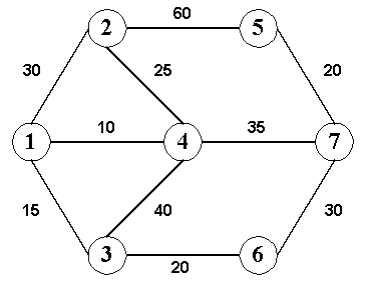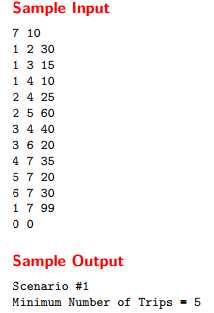标签:maximum oid following floyd 图片 rip last sid sig
Mr. G. works as a tourist guide. His current assignment is to take some tourists from one city to another. Some two-way roads connect the cities. For each pair of neighboring cities there is a bus service that runs only between those two cities and uses the road that directly connects them. Each bus service has a limit on the maximum number of passengers it can carry. Mr. G. has a map showing the cities and the roads connecting them. He also has the information regarding each bus service. He understands that it may not always be possible for him to take all the tourists to the destination city in a single trip. For example, consider the following road map of 7 cities. The edges connecting the cities represent the roads and the number written on each edge indicates the passenger limit of the bus service that runs on that road.

Now, if he wants to take 99 tourists from city 1 to city 7, he will require at least 5 trips and the route he should take is : 1 - 2 - 4 - 7. But, Mr. G. finds it difficult to find the best route all by himself so that he may be able to take all the tourists to the destination city in minimum number of trips. So, he seeks your help.
Input
The input will contain one or more test cases. The first line of each test case will contain two integers: N (N ≤ 100) and R representing respectively the number of cities and the number of road segments. Then R lines will follow each containing three integers: C1, C2 and P. C1 and C2 are the city numbers and P (P > 1) is the limit on the maximum number of passengers to be carried by the bus service between the two cities. City numbers are positive integers ranging from 1 to N. The (R + 1)-th line will contain three integers: S, D and T representing respectively the starting city, the destination city and the number of tourists to be guided. The input will end with two zeroes for N and R.
Output
For each test case in the input first output the scenario number. Then output the minimum number of trips required for this case on a separate line. Print a blank line after the output of each test case.

1 #include<stdio.h> 2 #include<string.h> 3 #include<algorithm> 4 #include<iostream> 5 using namespace std; 6 const int N=110; 7 #define inf 0x3f3f3f3f 8 int e[N][N]; 9 //int n; 10 11 //void init(int nn) 12 //{ 13 // for(int i=1; i<=nn; i++) 14 // { 15 // for(int j=1; j<=nn; j++) 16 // { 17 // if(i==j) 18 // e[i][j]=0; 19 // else 20 // e[i][j]=inf; 21 // } 22 // } 23 //} 24 25 26 int main() 27 { 28 int n,m; 29 int tt=1; 30 while(~scanf("%d %d",&n,&m)) 31 { 32 // init(n); 33 if(n==0&&m==0) 34 break; 35 memset(e,0,sizeof(e)); 36 int aa,bb,cc; 37 for(int i=1; i<=m; i++) 38 { 39 scanf("%d %d %d",&aa,&bb,&cc); 40 e[aa][bb]=e[bb][aa]=cc-1; 41 // e[aa][bb]=e[bb][aa]=cc; 42 } 43 for(int k=1; k<=n; k++) 44 { 45 for(int i=1; i<=n; i++) 46 { 47 for(int j=1; j<=n; j++) 48 { 49 // if(e[i][j]!=inf&&e[i][k]!=inf&&e[k][j]!=inf) 50 // e[i][j]=max(e[i][j],e[i][k]+e[k][j]); 51 e[i][j]=max(e[i][j],min(e[i][k],e[k][j])); 52 } 53 } 54 } 55 // int tt=1; 56 // cout<<e[1][7]<<"***"<<endl; 57 int a,b,c; 58 scanf("%d %d %d",&a,&b,&c); 59 int ans=(c-1)/e[a][b]; 60 // int ans=c/(e[a][b]-1); 61 if((c-1)%e[a][b]!=0) 62 // if(c%e[a][b]!=0) 63 ans++; 64 // ans=ans*2-1; 65 printf("Scenario #%d\n",tt++); 66 printf("Minimum Number of Trips = %d\n\n",ans); 67 } 68 return 0; 69 }
Frogger
Input
Output
Sample Input
2 0 0 3 4 3 17 4 19 4 18 5 0
Sample Output
Scenario #1 Frog Distance = 5.000 Scenario #2 Frog Distance = 1.414
1 #include<iostream> 2 #include<string.h> 3 #include<cmath> 4 #include<iomanip> 5 #define inf 0x3f3f3f3f 6 using namespace std; 7 8 //点点之间的距离floyd 9 //找a-b所有路径中最大步数里面最小的 10 struct edge 11 { 12 // double x; 13 // double y; 14 int x; 15 int y; 16 } e[220]; 17 18 double a[220][220]; 19 int n; 20 21 double d(int x1,int y1,int x2,int y2) 22 { 23 return sqrt(((x2-x1)*(x2-x1)*1.0+(y2-y1)*(y2-y1)*1.0)*1.0); 24 } 25 26 void init() 27 { 28 for(int i=1;i<=n;i++) 29 { 30 for(int j=1;j<=n;j++) 31 { 32 if(i==j) 33 a[i][j]=0; 34 else 35 a[i][j]=inf; 36 } 37 } 38 } 39 40 int main() 41 { 42 std::ios::sync_with_stdio(false); 43 cin.tie(0); 44 cout.tie(0); 45 int tt=1; 46 while(cin>>n) 47 { 48 if(n==0) 49 break; 50 memset(e,0,sizeof(e)); 51 memset(a,0,sizeof(a)); 52 init(); 53 for(int i=1; i<=n; i++)//n个顶点 54 cin>>e[i].x>>e[i].y; 55 56 // p=1;//p条边 57 58 for(int i=1; i<=n; i++) 59 { 60 for(int j=i+1; j<=n; j++) 61 { 62 // addedge[p++]=d(e[i].x,e[i].y,e[j].x,e[j].y); 63 64 double dd=d(e[i].x,e[i].y,e[j].x,e[j].y); 65 if(a[i][j]>dd||a[j][i]>dd) 66 { 67 a[j][i]=a[i][j]=dd; 68 } 69 } 70 } 71 // sort(addedge+1,addedge+p+1,cmp1); 72 for(int k=1;k<=n;k++) 73 { 74 for(int i=1;i<=n;i++) 75 { 76 for(int j=1;j<=n;j++) 77 { 78 //if(a[i][j]a[i][k]+a[k][j]) 79 a[i][j]=min(a[i][j],max(a[i][k],a[k][j])); 80 } 81 } 82 } 83 double dis=a[1][2]; 84 cout<<"Scenario #"<<tt++<<endl; 85 cout<<"Frog Distance = "; 86 cout<<setiosflags(ios::fixed)<<setprecision(3)<<dis<<endl<<endl; 87 } 88 return 0; 89 }
floyd类型题UVa-10099-The Tourist Guide +Frogger POJ - 2253
标签:maximum oid following floyd 图片 rip last sid sig
原文地址:https://www.cnblogs.com/OFSHK/p/11366514.html